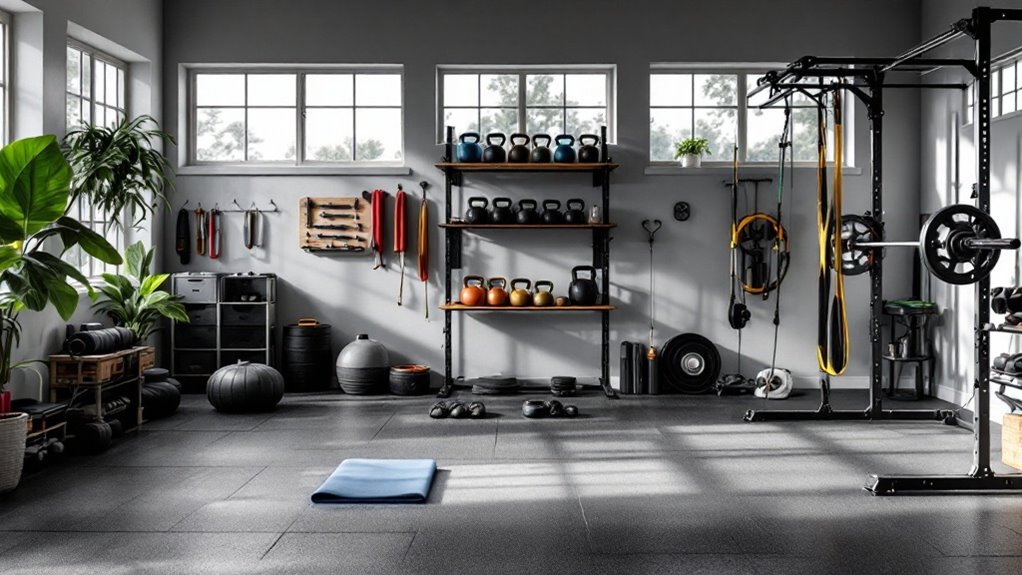Weight Lifting Routines for Women

Women can build strength and achieve their fitness goals through structured weight training programs tailored to their experience level. Beginners start with bodyweight exercises and light weights 2-3 times weekly, focusing on proper form and basic movements. Intermediate lifters progress to compound exercises 3-4 times weekly, while advanced athletes involve themselves in complex programming 4-5 times weekly. Proper equipment and technique optimize results and prevent injury. The journey to strength begins with understanding the fundamentals.
Key Takeaways
- Start with 2-3 weekly sessions focusing on bodyweight exercises and light weights to build proper form and confidence.
- Include basic compound movements like squats, lunges, and modified push-ups to develop foundational strength.
- Focus on progressive overload by gradually increasing weight and complexity as strength and technique improve.
- Incorporate core-strengthening exercises and maintain proper form to prevent injury and enhance overall stability.
- Track progress in a training log while ensuring adequate rest between sessions for optimal muscle recovery.
Key Benefits of Weight Training for Women

Strength lies at the core of every woman's journey to ideal health and fitness. Weight training delivers groundbreaking benefits that extend far beyond aesthetic improvements.
Women who incorporate resistance training experience increased bone density, improved metabolic rate, and better functional strength for daily activities.
Resistance training empowers women by building stronger bones, boosting metabolism, and enhancing everyday strength for a more capable life.
Regular weight training sessions boost confidence while sculpting lean muscle mass, which helps prevent age-related muscle loss. The hormonal benefits include better insulin sensitivity and increased production of growth hormone.
Women also report improved sleep quality, reduced stress levels, and enhanced mental clarity. These advantages combine to create a powerful foundation for long-term health and well-being.
Contrary to common misconceptions, ladies who lift weights won't develop bulky muscles due to their lower levels of testosterone and genetics.
Getting Started: Essential Equipment and Form

Proper equipment and form create the foundation for a successful weight training journey. Essential items include proper athletic shoes, comfortable moisture-wicking clothing, and a weight training belt for heavier lifts.
Women should begin with basic equipment like dumbbells, resistance bands, and weight machines before progressing to barbells.
Form is paramount for preventing injury and maximizing results. Key fundamentals include maintaining neutral spine orientation, engaging the core, controlling breathing patterns, and executing movements with intentional tempo.
It's advisable to work with a certified trainer initially to master proper form and technique for foundational exercises like squats, deadlifts, and presses.
Following a structured progressive overload approach helps women gradually increase weight and intensity as their strength improves.
Sample Workout Plans by Fitness Level

Every woman's fitness journey requires a personalized approach based on current capabilities, goals, and available time commitment.
Creating structured workout plans tailored to different fitness levels guarantees steady progress while minimizing injury risk.
A well-structured fitness program that matches your experience level is the key to sustainable results and safe training progress.
Regular weight training helps women achieve improved bone density and increased metabolic rate for better body composition.
- Beginner Level: Focus on bodyweight exercises and light weights, 2-3 sessions weekly
- Basic squats, lunges, modified push-ups
- Dumbbell rows, shoulder presses
- Core strengthening exercises
- Intermediate Level: Increase weight and complexity, 3-4 sessions weekly
- Compound movements, progressive overload
- Supersets, circuit training
- Advanced variations of basic exercises
- Advanced Level: Complex programming, 4-5 sessions weekly
- Olympic lifts, powerlifting techniques
- Periodization strategies
- Sport-specific training adaptations
Tips for Maximizing Results and Preventing Injury

To optimize the benefits of weight training while staying injury-free, women must implement proven safety protocols and training principles into their workout routines.
Essential tips include maintaining proper form during exercises, starting with lighter weights to master techniques, and gradually increasing intensity. Women should warm up thoroughly before lifting, stay hydrated, and listen to their bodies' signals.
Using a training log helps track progress and prevent overtraining.
Additional safety measures include working with a spotter when necessary, keeping core muscles active, and maintaining controlled breathing throughout movements.
Regular rest periods between workouts allow for adequate muscle recovery and reduce injury risk.
Following a structured progressive overload approach ensures continued strength gains while minimizing plateau effects.
Frequently Asked Questions
Can Weight Lifting Affect My Menstrual Cycle?
Exercise intensity, including weightlifting, can influence hormonal balance and menstrual cycles.
Some women experience temporary changes in cycle length or flow during intense training periods. Proper nutrition, adequate rest, and gradual progression help minimize disruptions.
While moderate weightlifting is generally safe, extreme training or very low body fat percentages may lead to amenorrhea. Athletes should monitor their cycles and consult healthcare providers if irregularities persist.
Will Taking Pre-Workout Supplements Cause Water Retention or Bloating?
Ah, the pre-workout dilemma – where fitness enthusiasts chase the perfect pump while their stomachs play bubble symphony.
Pre-workout supplements can indeed cause water retention and bloating, primarily due to ingredients like caffeine, creatine, and beta-alanine. These components may increase fluid retention and cause gastrointestinal discomfort.
However, effects vary by individual and product formulation.
Selecting supplements without creatine or reducing serving size can minimize these side effects.
How Do Birth Control Medications Impact Muscle Gains From Weight Training?
Birth control medications can affect muscle gains through their influence on hormones, particularly estrogen and progesterone.
These hormones may impact protein synthesis, recovery time, and fat distribution. Some women report minor decreases in strength gains, while others notice no significant changes.
The type of birth control and individual response varies.
Maintaining consistent training, proper nutrition, and adequate protein intake remains essential for muscle development regardless of birth control use.
Should I Adjust My Lifting Routine During Pregnancy?
Pregnant women should consult their healthcare provider before continuing or modifying weight training.
Generally, maintaining fitness during pregnancy is beneficial, but modifications are necessary.
Reduce weights by 20-30%, avoid exercises that strain the core or require lying flat on the back, and focus on maintaining rather than gaining strength.
Listen to the body's signals and stop if experiencing dizziness, pain, or discomfort.
Does Weight Training Affect Breast Size or Shape?
Studies show that 79% of women experience changes in breast tissue composition during their lifetime, regardless of exercise habits.
Weight training itself does not directly reduce or increase breast size, as breasts consist mainly of fat and glandular tissue.
However, developing the underlying chest muscles through training can improve posture and provide a lifting effect.
Overall body fat changes from exercise may impact breast size more than the weight training itself.
Final Thoughts
Research consistently demonstrates that women who incorporate weight training into their fitness routines experience profound physical and mental transformations. Beyond building lean muscle and boosting metabolism, regular strength training empowers women to break through perceived limitations and challenge societal stereotypes. As more women embrace the barbell, they prove that strength knows no gender – creating a powerful ripple effect that inspires future generations to discover their own strength, both inside and out.


